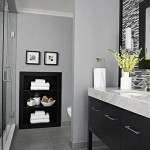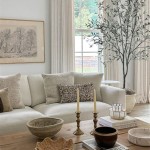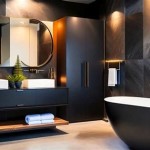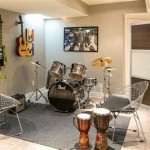How To Decorate a Dark Bedroom
Decorating a dark bedroom presents a unique set of challenges. Limited natural light can make the space feel small, cramped, and even depressing if not addressed thoughtfully. However, with strategic design choices, a dark bedroom can be transformed into a cozy, inviting, and stylish sanctuary. The key lies in understanding how to manipulate light, color, texture, and furniture placement to maximize the available light and create a sense of spaciousness.
Successfully decorating a dark bedroom involves a deliberate approach that prioritizes brightness and visual interest. This article will explore various strategies to achieve this, focusing on paint colors, lighting schemes, strategic use of mirrors, and the selection of furniture and accessories that complement the overall design.
Embracing Light Paint Colors and Strategic Color Placement
The most fundamental step in brightening a dark bedroom is selecting the appropriate paint colors. Light shades, particularly whites, off-whites, and pastels, are highly reflective and will bounce available light around the room, making it feel brighter and more spacious. Consider a range of whites with varying undertones to find one that complements the existing features of the room.
For instance, warm whites with yellow or beige undertones can create a cozy and inviting atmosphere, while cool whites with gray or blue undertones can provide a clean and modern feel. When choosing a white, it's crucial to test it in the room under different lighting conditions to see how it appears throughout the day. Samples can be painted on a small section of the wall, and observed over a period of several days to ensure the color is suitable.
Beyond the main wall color, strategic color placement can also influence the perceived brightness of the room. Use a lighter shade on the ceiling than on the walls. This helps to visually lift the ceiling, making the room feel taller. High-gloss or semi-gloss paint finishes will reflect more light than matte finishes, making them suitable for trim, doors, and smaller accent walls. However, high-gloss finishes are less forgiving of imperfections, so proper surface preparation is essential.
While light colors are generally recommended for dark bedrooms, incorporating darker accent colors can add depth and visual interest. These should be used sparingly to avoid overwhelming the space. A dark accent wall behind the bed, for instance, can create a focal point and add a touch of drama without significantly darkening the room. Alternatively, dark-colored accessories, such as throw pillows, blankets, or artwork, can be used to add pops of color and contrast.
Consider using a monochromatic color scheme, which involves using different shades and tints of a single color. This creates a cohesive and harmonious look, while also allowing for subtle variations in light reflection. For example, a room could be painted in various shades of gray, ranging from a light gray on the walls to a darker gray on the trim and a charcoal gray in the accessories.
The specific architectural features of the room should also be considered when selecting paint colors. Low ceilings may benefit from vertical stripes or a lighter color on the upper portion of the wall to create the illusion of height. Areas that receive even a small amount of natural light should be highlighted with lighter colors to maximize its impact.
Maximizing Light with Mirrors and Reflective Surfaces
Mirrors are powerful tools for brightening a dark bedroom. Strategically placed mirrors can reflect light, creating the illusion of a larger space and enhancing the overall brightness of the room. The larger the mirror, the greater its impact will be. A full-length mirror on a wall opposite a window can effectively double the amount of light entering the room.
Placement is key when using mirrors in a dark bedroom. Avoid placing mirrors in areas that reflect dark corners or blank walls, as this will not contribute to the overall brightness of the room. Instead, position them to reflect light sources, such as windows or lamps. A large mirror behind a bedside table lamp, for example, can amplify the light and create a warm and inviting glow.
In addition to large mirrors, smaller decorative mirrors can be used to add visual interest and reflect light in specific areas. A gallery wall of small mirrors, for instance, can create a focal point and add a touch of glamour to the room. Mirrored furniture, such as bedside tables or dressers, can also help to bounce light around the space.
Beyond mirrors, other reflective surfaces can contribute to the overall brightness of the room. Metallic accents, such as gold or silver lamps, picture frames, or decorative objects, can reflect light and add a touch of sparkle. Glass furniture, such as a coffee table or shelving unit, can also help to create a sense of openness and airiness.
Consider using reflective fabrics, such as silk or satin, for curtains or bedding. These fabrics will bounce light around the room, adding a touch of luxury and sophistication. Alternatively, fabrics with metallic threads can create a subtle shimmer that enhances the overall brightness of the space.
The finish of the furniture can also affect the amount of light reflected in the room. Light-colored furniture with a glossy finish will reflect more light than dark-colored furniture with a matte finish. Consider refinishing dark furniture with a lighter color or adding metallic accents to brighten it up.
Implementing a Layered Lighting Scheme
In a dark bedroom, artificial lighting is crucial for creating a bright and inviting atmosphere. Relying solely on a single overhead light will likely result in a harsh and unflattering illumination. A layered lighting scheme, which incorporates a variety of light sources at different levels, is essential for creating a balanced and well-lit space.
Ambient lighting provides the overall illumination for the room. This can be achieved through fixtures such as ceiling lights, recessed lights, or chandeliers. While overhead lighting should be minimized in a dark bedroom, it is still necessary to provide a base level of illumination. Opt for fixtures that provide a soft, diffused light rather than harsh, direct light. Dimmers are highly recommended for controlling the intensity of the ambient lighting and creating a more relaxed atmosphere.
Task lighting provides focused light for specific activities, such as reading or working. Bedside lamps are essential for task lighting in the bedroom. Choose lamps with adjustable arms or shades to direct the light where it is needed. Desk lamps can also be used for task lighting if the bedroom is used as a workspace.
Accent lighting is used to highlight specific features of the room, such as artwork or architectural details. Wall sconces, spotlights, or picture lights can be used to add visual interest and create a more dynamic lighting scheme. Consider using accent lighting to highlight areas that receive even a small amount of natural light, as this will help to amplify its impact.
The color temperature of the light bulbs used in the bedroom can also affect the overall atmosphere. Warm white light (2700-3000K) creates a cozy and inviting atmosphere, while cool white light (3500-4100K) provides a brighter and more energizing illumination. Choose light bulbs with a color temperature that complements the overall design of the room.
Consider using smart lighting systems that allow for remote control of the lights. These systems can be programmed to adjust the lighting levels throughout the day, creating a more comfortable and personalized atmosphere. They can also be used to create mood lighting for different activities, such as reading or relaxing.
The placement of light fixtures is also crucial for maximizing their impact. Position light fixtures to illuminate dark corners and highlight areas that receive natural light. Avoid placing light fixtures in areas that will cast shadows or create glare. Experiment with different lighting arrangements to find the optimal configuration for the room.

20 Dark Bedroom Ideas To Inspire A Moody Retreat

Dark Bedroom Ideas 13 Ways To Use Colours In Your

25 Moody Bedroom Ideas To Create A Dark Luxe Retreat

25 Dark Bedrooms That Will Make Every Night Enchanting

20 Dark Bedroom Ideas To Inspire A Moody Retreat

10 Simple Ideas For Brightening A Dark Bedroom Houzz

Dark Bedrooms Design Ideas Colour Farrow Ball

Dark Bedrooms Design Ideas Colour Farrow Ball

51 Dark Bedroom Ideas With Tips And Accessories To Help You Design Yours
:strip_icc()/cozy-bedroom-ideas-18-a322578437a54f0eb601b45b7ad69c95.jpeg?strip=all)
Dark Bedroom Ideas For A Moody And Dramatic Space







